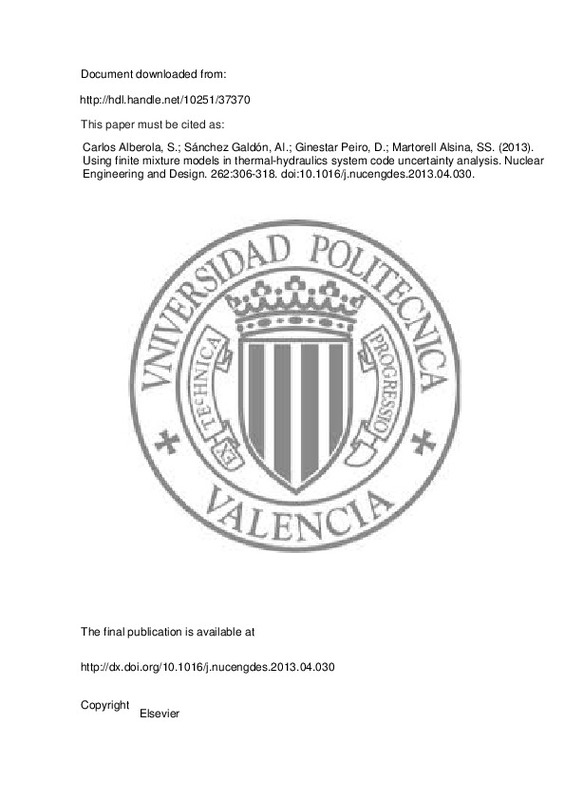JavaScript is disabled for your browser. Some features of this site may not work without it.
Buscar en RiuNet
Listar
Mi cuenta
Estadísticas
Ayuda RiuNet
Admin. UPV
Using finite mixture models in thermal-hydraulics system code uncertainty analysis
Mostrar el registro sencillo del ítem
Ficheros en el ítem
| dc.contributor.author | Carlos Alberola, Sofía
|
es_ES |
| dc.contributor.author | Sánchez Galdón, Ana Isabel
|
es_ES |
| dc.contributor.author | Ginestar Peiro, Damián
|
es_ES |
| dc.contributor.author | Martorell Alsina, Sebastián Salvador
|
es_ES |
| dc.date.accessioned | 2014-05-09T17:56:05Z | |
| dc.date.issued | 2013-09 | |
| dc.identifier.issn | 0029-5493 | |
| dc.identifier.uri | http://hdl.handle.net/10251/37370 | |
| dc.description.abstract | Nuclear Power Plant safety analysis is mainly based on the use of best estimate (BE) codes that predict the plant behavior under normal or accidental conditions. As the BE codes introduce uncertainties due to uncertainty in input parameters and modeling, it is necessary to perform uncertainty assessment (UA), and eventually sensitivity analysis (SA), of the results obtained. These analyses are part of the appropriate treatment of uncertainties imposed by current regulation based on the adoption of the best estimate plus uncertainty (BEPU) approach. The most popular approach for uncertainty assessment, based on Wilks' method, obtains a tolerance/confidence interval, but it does not completely characterize the output variable behavior, which is required for an extended UA and SA. However, the development of standard UA and SA impose high computational cost due to the large number of simulations needed. In order to obtain more information about the output variable and, at the same time, to keep computational cost as low as possible, there has been a recent shift toward developing metamodels (model of model), or surrogate models, that approximate or emulate complex computer codes. In this way, there exist different techniques to reconstruct the probability distribution using the information provided by a sample of values as, for example, the finite mixture models. In this paper, the Expectation Maximization and the k-means algorithms are used to obtain a finite mixture model that reconstructs the output variable probability distribution from data obtained with RELAP-5 simulations. Both methodologies have been applied to a separated effects experiment, and to an integral effects simulation. | es_ES |
| dc.description.sponsorship | This work has been partially supported by the Consejo de Seguridad Nuclear under the contract with reference STN/2369/08/640. | en_EN |
| dc.format.extent | 13 | es_ES |
| dc.language | Inglés | es_ES |
| dc.publisher | Elsevier | es_ES |
| dc.relation.ispartof | Nuclear Engineering and Design | es_ES |
| dc.rights | Reserva de todos los derechos | es_ES |
| dc.subject | Computational costs | es_ES |
| dc.subject | Current regulations | es_ES |
| dc.subject | Expectation - maximizations | es_ES |
| dc.subject | Finite mixture models | es_ES |
| dc.subject | k-Means algorithm | es_ES |
| dc.subject | Nuclear power plant safeties | es_ES |
| dc.subject | Thermal hydraulics | es_ES |
| dc.subject | Uncertainty assessment | es_ES |
| dc.subject | Reactor safety margins | es_ES |
| dc.subject | Adjoint sensitivity-analysis | es_ES |
| dc.subject | Artificial neural-networks | es_ES |
| dc.subject | Parameters | es_ES |
| dc.subject.classification | ESTADISTICA E INVESTIGACION OPERATIVA | es_ES |
| dc.subject.classification | INGENIERIA NUCLEAR | es_ES |
| dc.subject.classification | MATEMATICA APLICADA | es_ES |
| dc.title | Using finite mixture models in thermal-hydraulics system code uncertainty analysis | es_ES |
| dc.type | Artículo | es_ES |
| dc.embargo.lift | 10000-01-01 | |
| dc.embargo.terms | forever | es_ES |
| dc.identifier.doi | 10.1016/j.nucengdes.2013.04.030 | |
| dc.relation.projectID | info:eu-repo/grantAgreement/CSN//STN%2F2369%2F08%2F640/ | es_ES |
| dc.rights.accessRights | Abierto | es_ES |
| dc.contributor.affiliation | Universitat Politècnica de València. Departamento de Ingeniería Química y Nuclear - Departament d'Enginyeria Química i Nuclear | es_ES |
| dc.contributor.affiliation | Universitat Politècnica de València. Departamento de Estadística e Investigación Operativa Aplicadas y Calidad - Departament d'Estadística i Investigació Operativa Aplicades i Qualitat | es_ES |
| dc.contributor.affiliation | Universitat Politècnica de València. Departamento de Matemática Aplicada - Departament de Matemàtica Aplicada | es_ES |
| dc.contributor.affiliation | Universitat Politècnica de València. Grupo de Medioambiente y Seguridad Industrial (MEDASEGI) | es_ES |
| dc.contributor.affiliation | Universitat Politècnica de València. Instituto Universitario de Matemática Multidisciplinar - Institut Universitari de Matemàtica Multidisciplinària | es_ES |
| dc.description.bibliographicCitation | Carlos Alberola, S.; Sánchez Galdón, AI.; Ginestar Peiro, D.; Martorell Alsina, SS. (2013). Using finite mixture models in thermal-hydraulics system code uncertainty analysis. Nuclear Engineering and Design. 262:306-318. https://doi.org/10.1016/j.nucengdes.2013.04.030 | es_ES |
| dc.description.accrualMethod | S | es_ES |
| dc.relation.publisherversion | http://dx.doi.org/10.1016/j.nucengdes.2013.04.030 | es_ES |
| dc.description.upvformatpinicio | 306 | es_ES |
| dc.description.upvformatpfin | 318 | es_ES |
| dc.type.version | info:eu-repo/semantics/publishedVersion | es_ES |
| dc.description.volume | 262 | es_ES |
| dc.relation.senia | 249613 | |
| dc.contributor.funder | Consejo de Seguridad Nuclear | es_ES |







![[Cerrado]](/themes/UPV/images/candado.png)

